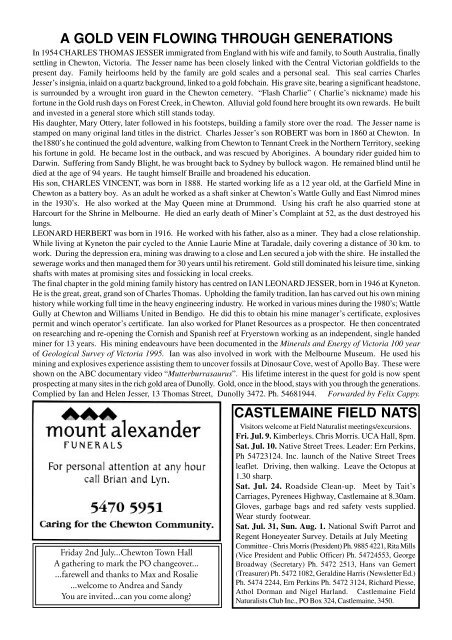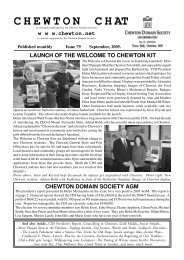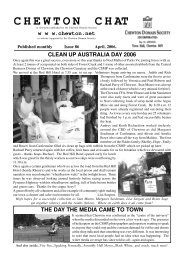July 2004 - Chewton.net
July 2004 - Chewton.net
July 2004 - Chewton.net
Create successful ePaper yourself
Turn your PDF publications into a flip-book with our unique Google optimized e-Paper software.
A GOLD VEIN FLOWING THROUGH GENERATIONS<br />
In 1954 CHARLES THOMAS JESSER immigrated from England with his wife and family, to South Australia, finally<br />
settling in <strong>Chewton</strong>, Victoria. The Jesser name has been closely linked with the Central Victorian goldfields to the<br />
present day. Family heirlooms held by the family are gold scales and a personal seal. This seal carries Charles<br />
Jesser’s insignia, inlaid on a quartz background, linked to a gold fobchain. His grave site, bearing a significant headstone,<br />
is surrounded by a wrought iron guard in the <strong>Chewton</strong> cemetery. “Flash Charlie” ( Charlie’s nickname) made his<br />
fortune in the Gold rush days on Forest Creek, in <strong>Chewton</strong>. Alluvial gold found here brought its own rewards. He built<br />
and invested in a general store which still stands today.<br />
His daughter, Mary Ottery, later followed in his footsteps, building a family store over the road. The Jesser name is<br />
stamped on many original land titles in the district. Charles Jesser’s son ROBERT was born in 1860 at <strong>Chewton</strong>. In<br />
the1880’s he continued the gold adventure, walking from <strong>Chewton</strong> to Tennant Creek in the Northern Territory, seeking<br />
his fortune in gold. He became lost in the outback, and was rescued by Aborigines. A boundary rider guided him to<br />
Darwin. Suffering from Sandy Blight, he was brought back to Sydney by bullock wagon. He remained blind until he<br />
died at the age of 94 years. He taught himself Braille and broadened his education.<br />
His son, CHARLES VINCENT, was born in 1888. He started working life as a 12 year old, at the Garfield Mine in<br />
<strong>Chewton</strong> as a battery boy. As an adult he worked as a shaft sinker at <strong>Chewton</strong>’s Wattle Gully and East Nimrod mines<br />
in the 1930’s. He also worked at the May Queen mine at Drummond. Using his craft he also quarried stone at<br />
Harcourt for the Shrine in Melbourne. He died an early death of Miner’s Complaint at 52, as the dust destroyed his<br />
lungs.<br />
LEONARD HERBERT was born in 1916. He worked with his father, also as a miner. They had a close relationship.<br />
While living at Ky<strong>net</strong>on the pair cycled to the Annie Laurie Mine at Taradale, daily covering a distance of 30 km. to<br />
work. During the depression era, mining was drawing to a close and Len secured a job with the shire. He installed the<br />
sewerage works and then managed them for 30 years until his retirement. Gold still dominated his leisure time, sinking<br />
shafts with mates at promising sites and fossicking in local creeks.<br />
The final chapter in the gold mining family history has centred on IAN LEONARD JESSER, born in 1946 at Ky<strong>net</strong>on.<br />
He is the great, great, grand son of Charles Thomas. Upholding the family tradition, Ian has carved out his own mining<br />
history while working full time in the heavy engineering industry. He worked in various mines during the 1980’s; Wattle<br />
Gully at <strong>Chewton</strong> and Williams United in Bendigo. He did this to obtain his mine manager’s certificate, explosives<br />
permit and winch operator’s certificate. Ian also worked for Pla<strong>net</strong> Resources as a prospector. He then concentrated<br />
on researching and re-opening the Cornish and Spanish reef at Fryerstown working as an independent, single handed<br />
miner for 13 years. His mining endeavours have been documented in the Minerals and Energy of Victoria 100 year<br />
of Geological Survey of Victoria 1995. Ian was also involved in work with the Melbourne Museum. He used his<br />
mining and explosives experience assisting them to uncover fossils at Dinosaur Cove, west of Apollo Bay. These were<br />
shown on the ABC documentary video “Mutterburrasaurus”. His lifetime interest in the quest for gold is now spent<br />
prospecting at many sites in the rich gold area of Dunolly. Gold, once in the blood, stays with you through the generations.<br />
Complied by Ian and Helen Jesser, 13 Thomas Street, Dunolly 3472. Ph. 54681944. Forwarded by Felix Cappy.<br />
Friday 2nd <strong>July</strong>...<strong>Chewton</strong> Town Hall<br />
A gathering to mark the PO changeover...<br />
...farewell and thanks to Max and Rosalie<br />
...welcome to Andrea and Sandy<br />
You are invited...can you come along?<br />
CASTLEMAINE FIELD NATS<br />
Visitors welcome at Field Naturalist meetings/excursions.<br />
Fri. Jul. 9. Kimberleys. Chris Morris. UCA Hall, 8pm.<br />
Sat. Jul. 10. Native Street Trees. Leader: Ern Perkins,<br />
Ph 54723124. Inc. launch of the Native Street Trees<br />
leaflet. Driving, then walking. Leave the Octopus at<br />
1.30 sharp.<br />
Sat. Jul. 24. Roadside Clean-up. Meet by Tait’s<br />
Carriages, Pyrenees Highway, Castlemaine at 8.30am.<br />
Gloves, garbage bags and red safety vests supplied.<br />
Wear sturdy footwear.<br />
Sat. Jul. 31, Sun. Aug. 1. National Swift Parrot and<br />
Regent Honeyeater Survey. Details at <strong>July</strong> Meeting<br />
Committee - Chris Morris (President) Ph. 9885 4221, Rita Mills<br />
(Vice President and Public Officer) Ph. 54724553, George<br />
Broadway (Secretary) Ph. 5472 2513, Hans van Gemert<br />
(Treasurer) Ph. 5472 1082, Geraldine Harris (Newsletter Ed.)<br />
Ph. 5474 2244, Ern Perkins Ph. 5472 3124, Richard Piesse,<br />
Athol Dorman and Nigel Harland. Castlemaine Field<br />
Naturalists Club Inc., PO Box 324, Castlemaine, 3450.




